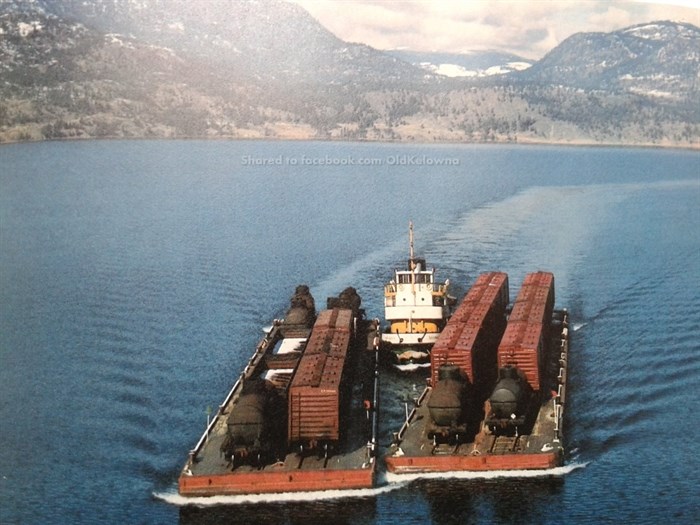
This undated image from the Old Kelowna Facebook group shows a tugboat on Okanagan Lake heading toward the bridge pushing two barges carrying rail cars.
Image Credit: SUBMITTED/ FACEBOOK/ Nicholas Morant
June 02, 2025 - 6:00 AM
At one time Okanagan Lake was a bustling transportation route with boats and ferries of all shapes and sizes moving passengers and freight up and down the lake.
One type of boat that worked on the water were the sturdy little tugboats that pushed log booms, towed scows filled with freight and even pulled barges carrying railway cars.
The tugs operated day and night, and the crews lived aboard.
Williams Lake resident Pat Blackwood’s dad was born in Kelowna in 1928 and was the first mate on a CN tug in the late 1940s.
“He was dating my mom at that time and when you left and went on the tugs there was no phone, there was nothing and she never knew when he was coming back,” he said.
“Tug crews would go up and down the lake and deliver railway cars to different sidings at places like Carr’s Landing and Okanagan Landing. That’s how everyone got their freight and moved produce like apples.”
In the late 1800s, the SS Penticton was the first tugboat used by the Kelowna Sawmill Company to move log booms to their mill and deliver lumber to various destinations around the lake. More wooden tugs were built for the logging industry in the years that followed, according to the Okanagan History fifty-sixth report of the Okanagan Historical Society.
Okanagan Lake tugboats moved building stone from the granite quarry on the lakeshore south of Vernon beginning in the early 1900s.
The tugboats used to move the barges carrying railway cars and break up lake ice in the winter were the largest tugs, operated by the Canadian Pacific Railway and Canadian National Railway.
Blackwood said inland railway tracks ended at a depot where Delta Hotels Grand Okanagan Resort is now in Kelowna.
“I can remember as a kid in the 60s visiting my grandparents in Kelowna and going down to the waterfront with my dad," he said. "He showed me where he used to work and told me about the tugboats, they were still there at that time.”
READ MORE: The long history of paddle wheelers between Kamloops and Enderby
The railway cars were carried on double tracked decks and the barges docked at specialized docks called car slips that used moveable aprons with tracks that could be connected to the tracks on the barges, according to the Okanagan Historical Society.
Several ferry boats were altered to become tugboats according the changing economic needs, but the first CPR boat on the lake that was built to be a tug and nothing else, was the S.S. Castlegar built out of wood in the shipyard at Okanagan Landing in Vernon in 1911. The S.S. Naramata was launched in 1913 and the SS Kelowna was launched in 1920.
The M.V. Pentowna was operated by CN as a passenger and freight boat travelling between Kelowna and Penticton, and partway through its service between 1914 and 1972, it was turned into a tugboat working in the CN railcar barge service.
One of the largest CN tugs in service was NO. 6. It was 89.5 feet in length with a 20-foot beam and was powered by a 575 horse power diesel engine. The tug worked on the lake from 1948 to 1973 and moved the last barge of freight cars on the lake.
READ MORE: A look back at the glory days of celery production in the Okanagan
The MV Okanagan tugged for the CPR from 1947 to 1972. It was 110 feet long with a beam of 23 feet. It had an 800 horse power diesel engine and was equipped with shore radio and radar. It was the largest and last CPR operated tugboat on the lake.
Captain Sam Podmoroff was a notable skipper who worked with Canadian Pacific for 31 years and was the Okanagan's last skipper. He docked the ship for the last time in 1972, marking the end of Canadian Pacific’s service on Okanagan Lake.
To contact a reporter for this story, email Shannon Ainslie or call 250-819-6089 or email the editor. You can also submit photos, videos or news tips to the newsroom and be entered to win a monthly prize draw.
We welcome your comments and opinions on our stories but play nice. We won't censor or delete comments unless they contain off-topic statements or links, unnecessary vulgarity, false facts, spam or obviously fake profiles. If you have any concerns about what you see in comments, email the editor in the link above. SUBSCRIBE to our awesome newsletter here.
News from © iNFOnews, 2025